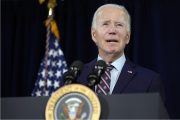
With the new school year upon us, the federal government is once again turning its attention to school lunches, claiming it is a matter of national security.
New rules from the U.S. Department of Agriculture (USDA) state that public schools cannot feature Gatorade and caffeine-filled drinks in their cafeterias. The Washington Times reports, “The department’s new rules come in the form of Smart Snacks in School nutrition standards, part of the fallout from the first lady Michelle Obama-fueled Healthy, Hunger-Free Kids Act of 2010. Under the rules, middle schools can’t provide kids with Gatorade, some tea drinks, lemonades, fruit punches or caffeinated beverages.”
Additionally, the USDA regulations mandate that snack items available in schools must have less than 230 mg of sodium, which means that even a 100-calorie package of cheese and crackers would not be permissible because they surpass that requirement. An exception could only be made if the school chooses to sell the crackers as an “entree” item à la carte.
The USDA claims that their rules reflect “carefully balanced science-based nutrition guidelines with practical and flexible solutions to promote healthier eating on campus.”
And some schools are more than willing to comply, even surpassing the standards set by the Hunger-Free Kids Act. As noted by the Washington Times, Socastee High School in South Carolina is now banning students from purchasing Chick-fil-A sandwiches at school, and all Banks County schools in Georgia will be locking down their vending machines during breakfast and lunch hours.
Some parents are applauding this sort of overreach, even lobbying for further regulations. According to National Review, a Minnesota bureaucrat is asking schools in her district to ban chocolate milk, while a mother in Massachusetts is seeking to eliminate peanuts.
“A peanut-butter sandwich is a bullet to my child, only it’s guaranteed death for her,” Jennifer Gagne told WGGB. “It’s not a maybe she might die. It’s if she ingests any kind of peanuts, there’s little-to-zero chance for her to survive it.”
To ensure compliance with the new rules, the Department of Agriculture has created a chart to help schools determine good replacements for banned foods. The chart recommends that schools replace such fare as Oreos and soda with “light popcorn” and “no-calorie flavored water.”
All of this is done under the guise of addressing obesity, which the USDA claims is a matter of national security.
“Obesity is not just a health issue,” Kevin Concannon, the department’s undersecretary for food, nutrition and consumer services, said. “It is an economic and national security issue.”
This is not the first time that the government has made such outrageous claims. According to First Lady Michelle Obama, obesity is a national security problem.
In December, 2010, she said in prepared remarks: “Military leaders tell us that when more than one in four young people are unqualified for military service because of their weight, childhood obesity isn’t just a public health threat, it’s not just an economic threat, it’s a national security threat as well.”
In other words, the government’s insistence on tackling the obesity epidemic in the United States is not as intrinsically inspired by a desire to aid the American people as they would like for us to believe, nor is it entirely driven by money. How else can they assure that they have enough soldiers to fight in the numerous wars in which they would like for the American military to be engaged?
But the USDA regulations may prompt some school districts to opt out of the federal program. The Chicago Tribune reports, for example, that the Catlin Community School District 5 is opting out of the program this year. That school district is not alone, with Maine Township High School District 207 and Niles Township High School District 219 having already left the program in recent years.
This is nothing new, as school districts were opting out of the program last year once it became clear that compliance was creating a costly fiasco.
Last year, New York’s Burnt Hills-Ballston Lake school district elected to opt out of Michelle Obama’s menu plan after too many students complained that they were still hungry after eating the prepared lunches.
“[Food service manager Nicky] Boehm and her staff worked hard to implement the new regulations, but there were just too many problems and too many foods that students did not like and would not purchase,” said Assistant Superintendent Chris Abdoo about the National School Lunch Program in a statement reported by EAGNews.org. “Students complained of being hungry with these lunches and the district lost money.”
EAGNews noted that the federal menu included minute portions, such as part of a chicken patty on a tiny croissant. Boehm said, “Students felt they weren’t getting good value for their money. The high schoolers especially complained the portion sizes were too small and many more students brought in lunch from home.”
Meanwhile the school lost approximately $100,000 attempting the federal menu.
Similarly, schools in Carmel Clay, Indiana, dropped the new meal plans last year, asserting that they lost $300,000 attempting to implement the menu only to find that students were rejecting it.
“I’ve had a lot of complaints, especially with the little guys,” Linda Wireman, the food service director for Indiana’s Monon-based North White School Corp., told JCOnline last year. “They get a three-quarters cup of vegetables, but if it’s something they don’t like, it goes down the garbage disposal. So there are a lot of complaints they’re going home hungry.”
Lori Shofroth, Tippecanoe School Corps’ Food service director in Tippecanoe, Indiana, stated that students had been throwing the food away.
“They’re teaching our kids with this meal pattern that it’s OK to throw away,” she told JCOnline. “We did a waste study on three different schools, and there was a huge amount of waste. That was just with produce, fruit or vegetables or milk.”
Ironically, wasted food was one of the very things First Lady Michelle Obama had hoped to avoid. Appearing at a Google Fireside Hangout in 2012, she declared, “I want every kid to commit to not throwing out anything.”
What’s worse is that some students opted not to eat the lunch at all — defeating the alleged purpose of the program, which was to ensure that students receive at least one solid meal a day.
Leave it to the federal government to send students home hungry as a result of something called the “Hunger-Free Kids Act.” And whether the “Hunger-Free Kids Act” should even exist is another issue. Critics contend that the federal government should have no role in the dietary habits of the American people.
During an appearance at Wade’s Southern Cooking in Spartanburg, South Carolina, Fred Thompson summed up the issue of government intervention in American diets rather well. “I’m telling you, I don’t think that it’s the primary responsibility of the federal government to tell you what to eat,” the former U.S. senator from Tennessee said. “The fact of the matter is we got an awful lot of knowledge,” said Thompson. “Sometimes we don’t have a whole lot of will power, and I don’t know of any government program that’s going to instill that.”
And while the government has not decided it has the authority to take complete control of our diets, at least not yet, it has engaged in these sorts of endeavors to “nudge” us in the right direction.
That notion seems to come straight from Cass Sunstein, the Obama administration’s former regulatory czar who authored the book Nudge — Improving Decisions about Health, Wealth, and Happiness. Sunstein’s book provides a variety of measures that can be taken in order to “nudge” Americans toward healthier lifestyles while giving the appearance that Americans are in fact making the decisions themselves, through the employment of behavioral psychology.
This is the driving premise behind Nanny State regulations such as the super-sized soda ban in New York City, the removal of toys from Happy Meals in San Francisco — and of course, the federal lunch program.




